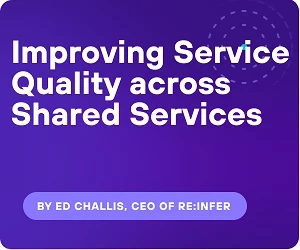Three Tools Every Shared Services Leader Needs for Automation In 2022
Add bookmark
Shared and global business services leaders face a new year and many new questions. The previous two years have been dominated by unprecedented disruption and innovation as service functions adopted new technologies to cope with surging request volumes - emails, service requests and support tickets.
Robotic process automation (RPA) cemented its position as one of the most popular and widespread technologies adopted by shared services leaders. However, the impact on operational efficiency has been more muted than many have hoped. Nearly half (46%) of service functions that have deployed RPA have seen less than 10% in savings, while agents continue to struggle with countless inbound requests.
When shared services aren’t running efficiently, the whole business suffers. Thankfully shared services leaders are finding a solution in intelligent automation. By combining traditional automation solutions with the latest AI tools, they can level up the benefits of automation by scaling it across the enterprise. With added cognitive intelligence, a simple RPA system can automate complex processes never thought possible.
Here are three intelligent automation tools that will supercharge your automation ROI in 2022 and beyond:
Conversational Data Intelligence
One of the largest challenges facing shared services - on top of ever-growing request volumes and the shift to hybrid working - is the lack of insight into the demand that is driving these shifts. To plan and resource effectively, it’s vital that shared services and transformation leaders understand which requests are creating the most work, and what the problems are that slow business-critical processes. It’s critical they understand not only how work is getting done, but why workflows are being triggered in the first place. This helps them resolve issues at the source rather than just treating the symptoms periodically.
However, much of this insight is hidden in unstructured communications data - primarily within emails and tickets - that can’t be analysed or automated by most traditional automation tools. Being able to process and understand all this unstructured data at the scale and speed required demands strong natural language processing (NLP) and analytical capabilities, which thankfully can be found in Conversational Data Intelligence tools.
Conversational Data Intelligence platforms combine NLP and machine learning to rapidly train models that can accurately and reliably convert freeform natural language into structured data that’s ready for analysis and automation. Shared services leaders then have the insight and data they need to scale automation effectively and drive improvements that deliver real ROI. That’s why 67% of shared services leaders say data extraction from email using NLP is a key investment priority.
Process Mining & Task Mining
A suite of automated process discovery tools is starting to make waves by helping organisations understand processes at an unprecedented level of detail. Though not purely focused on automation opportunities alone, these technologies will provide insight into process efficiency that’s hard to match.
Process Mining and Task Mining are technology platforms that can enhance process discovery and improvement initiatives. Automated process discovery is like lean on steroids. Using system, click, and user behaviour data, these tools show the reality of processes rather than a picture distorted by the opinions of subject matter experts. This gives you a baseline to understand the work service agents are completing, while also revealing a pathway for future process improvements and automations.
OCR & IDP
Optical character recognition (OCR) and intelligent document processing (IDP) are also seeing a huge boost in usage thanks to the growing focus of intelligent automation on RPA. Adding document understanding to your shared service capability provides a whole new area of work to be structured, digitised and therefore automated by RPA. If semi-structured documents, such as invoices and application forms, are now fair game thanks to OCR and IDP technologies, organisations gain easy access to masses of new structured data sources.
Conclusion
Conversational Data Intelligence, digitisation and automated process discovery tools are playing an increasingly important role in intelligent automation. Shared services leaders should embrace these tools and explore how they can be used to drive process understanding, straight-through processing, and hyperautomation.
If the previous two years have been about laying the foundation for automation success, 2022 will be the year shared services unlocks its benefits.
Learn more about the intelligent automation solution stack that’s transforming shared services.
















